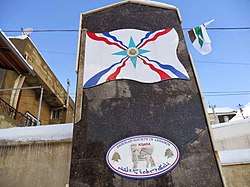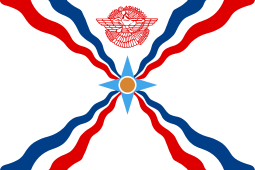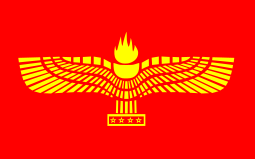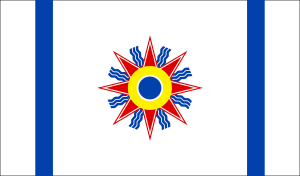Assyrians in Lebanon
Assyrians in Lebanon (Syriac: ܐܬܘܪܝܐ ܕܠܒܢܢ, Arabic: الآشوريين في لبنان) (French: Libanais-Assyriens) are Lebanese citizens of Assyrian descent. Most of the Assyrians in Lebanon came as refugees from northern Iraq and northeast Syria, two of the four locations of the Assyrian homeland.[2][3] There are an estimated 40,000 to 80,000 Iraqi Assyrian refugees in Lebanon. The vast majority of them are undocumented, with a large number having been deported or put in prison. [4]
ܐܬܘܪܝܐ ܕܠܒܢܢ | |
|---|---|
 Assyrian flag plaque outside the Assyrian Society of Lebanon | |
| Total population | |
| Up to 80,000[1] | |
| Regions with significant populations | |
| Beirut (Achrafieh) Jdeideh Zahlé | |
| Languages | |
| Neo-Aramaic, Arabic, French | |
| Religion | |
| Syriac Christianity | |
| Related ethnic groups | |
| Maronites |
History
Ancient history
Most Assyrians in Lebanon have migrated in recent decades, however, the Assyrian presence in Lebanon dates back to 883BC when Lebanon was controlled by the Assyrians during the Middle Assyrian Empire and Neo-Assyrian Empire. [5]
In 868 BCE Ashurnasirpal II reached the Mediterranean and exacted tribute from the Phoenician cities. His son, Shalmaneser III, took tribute from the Tyrians and Sidonians and established a supremacy over Phoenicia, which was acknowledged by occasional payments of tribute to him and his successors. In 734 BCE Tiglath-pileser III in his western campaign established his authority over Byblos, Arados, and Tyre. A fresh invasion by Shalmaneser V took place in 725 when he was on his way to Samaria, and in 701 Sennacherib, facing a rebellion of Philistia, Judah, and Phoenicia, drove out and deposed Luli, identified as king of both Sidon and Tyre. In 678 Sidon rebelled against the Assyrians, who marched down and annihilated the city, rebuilding it on the mainland. Sieges of Tyre took place in 672 and 668, but the city resisted both, only submitting in the later years of Ashurbanipal. [6]
Modern history
Assyrians are one of several minority groups in Lebanon. A Syriac Orthodox (Jacobite) community settled in Lebanon among the Maronites after Mongol invasions in the Late Middle Ages, however, this community was either dispersed or absorbed by the Maronites. [7] Assemani (1687–1768) noted that many Maronite families were of Jacobite origin.[7] A Jacobite community was present in Tripoli in the 17th century.[7]
The 1915 Assyrian genocide forced Western Assyrians from Tur Abdin to flee to Lebanon, where they formed communities in the Beirut districts of Zahlah and Musaytbeh.[8] Assyrian refugees from French Cilicia arrived in 1921 to bolster their numbers.[8] In 1944 it was estimated that 3,753 Syriac Orthodox Assyrians lived in Lebanon.[9]
Prior to the Lebanese Civil War (1975–1990), there were 65,000 Syriac Orthodox Assyrians in the country.[8] Half of the community emigrated as a result of violence, with many going to Sweden, which protected "stateless people".[8] As of 1987 there were only a few thousand Syriac Orthodox Assyrians in Lebanon.[10]
Assyrians remained neutral during the events of the Lebanese Civil War; however, individuals joined several armed forces, mainly working closely together with the founder and leader of the Lebanese Forces militia Bachir Gemayel and Christian groups such as the Tyous Team of Commandos and the Shuraya Party.
An influx of Assyrian refugees occurred due to the 2003 Invasion of Iraq and Iraqi Civil War, with Assyrians from Iraq fleeing to Lebanon as refugees in order to immigrate to Europe, the United States, and Australia. A third exodus has begun since 2011 as droves of Assyrians have fled Syria due to the Syrian Civil War, mainly settling in Sed El Baouchrieh. [11][12][13]
Education
The St George Assyrian School (French: Ecole St-Georges Assyrienne) is an Assyrian school in Lebanon that is run by the Assyrian Church of the East. It is located in Sed El Baouchrieh. The school provides classes up to the third grade and has 150 students, of which 100 are Assyrians. One hour of Assyrian language lessons per week is compulsory for Assyrian students, with language courses available in the summer as well. [14]
Politics
There are a number of Assyrian political parties that represent the local population in Lebanon. Majority of the Assyrian political parties in Lebanon are part of the March 14 Alliance and include the following parties:
Religion
The majority of Assyrians in Lebanon are Christians who adhere to the East and West Syriac Rite. These include the following churches:
Catholic Assyrians
Chaldean Catholic Church
There is an estimated 20,000 Chaldean Catholic adherents in Lebanon, the majority being refugees from Iraq. The Chaldean Catholic Eparchy of Beirut was established on the 3rd of July 1957 and the main parish in the country is St Raphael Chaldean Catholic Cathedral. [15] [16]
Syriac Catholic Church
The Patriarch Ignatius Joseph III Yonan of the Syriac Catholic Church currently resides in Beirut, where the church is based. The church owns a summer residence in Deir El Sherfet on top of Mount Lebanon. [17] In 1817, a Syriac Catholic diocese was established in Beirut, but has remained vacant since 1898. The diocese of Beirut is currently under the jurisdiction of a patriarchal vicar or apostolic administrator since its vacancy.
According to Catholic statistics from 1962, the Syriac Catholic Church had 6 parishes in Lebanon, accounting for 6 churches, 14 priests and 14,500 adherents. In 1964, this grew to 8 churches and 15,000 adherents.
Orthodox Assyrians
Syriac Orthodox Church
The Syriac Orthodox Church of Antioch is represented in Lebanon under the following clergymen:
- Archbishopric of Mount Lebanon under Mor Theophilos George Saliba
- Patriarchal Vicate of Zahle under Mor Justinos Boulos Safar
- Archbishopric of Beirut & Benevolent institutions in Lebanon under Mor Clemis Daniel Malak Kourieh
- Patriarchal Institutions in Lebanon under Mor Chrysostoms Michael Shamoun.
Church of the East
The Assyrian Church of the East (ACOE) in Lebanon is part of the Archdiocese of Australia, New Zealand and Lebanon, under the leadership of Mar Meelis Zaia.
The ACOE churches in Lebanon include:
- Mar Gewargis (Sed El Baouchrieh), built in 1953
- Mar Zaya (Ksara, Zahlé)
- Rabban Pethyoun (Hadath)
- Mar Khnanya (Achrafieh)
Notable People
See also
References
- "Lebanon: Assyrian Policy Institute".
- Carl Skutsch (2013). Encyclopedia of the World's Minorities. Routledge. p. 149. ISBN 978-1-135-19388-1.
- Lebanon Assyrian or Nestorian Church - Flags, Maps, Economy, History, Climate, Natural Resources, Current Issues, International Agreements, Population, Social Statistics, Political System
- Assir, Serene (September 4, 2007). "Invisible Lives:Iraqis In Lebanon". Assyrian International News Agency. Retrieved 2007-08-15.
- Healy, Mark (1991). The Ancient Assyrians. New York: Osprey. pp. 8–53.
- "Lebanon". Britannica. Retrieved 12 July 2019.
- Joseph 1983, p. 111.
- Hunter 2014, p. 548.
- A. H. Hourani (1947). Minorities in the Arab World. London: Oxford University Press.
- John C. Rolland (2003). Lebanon: Current Issues and Background. Nova Publishers. pp. 79–. ISBN 978-1-59033-871-1.
- Collins, Dylan. "Fleeing ISIL, Assyrian refugees mark Easter in Lebanon". Al-Jazeera. Retrieved 18 June 2019.
- Abou Rahal, Layal. "Assyrians struggle in Lebanon after fleeing IS jihadists". Yahoo. AFP. Retrieved 18 June 2019.
- Samaha, Nour. "Syria's Assyrians: 'No one helped us'". Al-Jazeera. Retrieved 18 June 2019.
- "Une école, une église et une histoire jalonnée de persécutions". L'Orient-Le Jour. Retrieved 12 July 2019.
- "Chaldean Catholic Church". Catholics and Cultures. Retrieved 24 June 2019.
- "Chaldean Diocese of Beirut". gcatholic. Retrieved 24 June 2019.
- Abraham, Salim. "The Iraqis determined to seize control of their future after fleeing ISIS". Catholic Herald. Retrieved 24 June 2019.
- 1932 Census; British Journal of Middle Eastern Studies, Vol. 26, No. 2, (Nov., 1999), pp. 219-241
- 1956 Estimates; International Journal of Middle East Studies, Vol. 11, No. 2, (Apr., 1980), pp. 175-187


